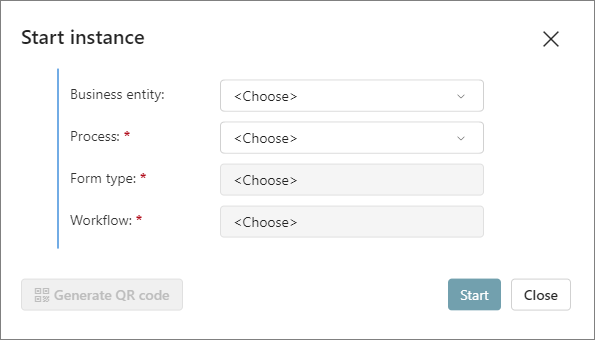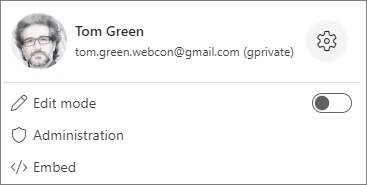Application home
Application is a visualization layer which serves as the user's workspace. It groups processes that are related to each other. This is where the start buttons, reports and dashboards are placed. Access to applications requires defining permissions for users, regardless of process and data privileges.
Each application has its own page also known as the dashboard. To access the application page, you may search for the application in the Choose application section, click on the corresponding tile in the Frequently used applications section, or select it from the Available applications list on the Portal home page.

Application panel
By default, each application dashboard contains basic identifying information such as name and description, as well as details about the Application supervisor, i.e. the person who created and manages the application. Additionally, it includes task counters whose values are presented in the context of the currently logged-in user.
Application privileges
An application can be accessed and used by users who have been granted the appropriate privileges. The largest range of privileges (right after the system administrator) is held by the Application administrator, who can freely modify the application, add and change its processes, presentation elements, etc.
Detailed information on this topic is available in the Privileges section of the Designer Studio chapter.
Register new instance
The section contains start buttons, i.e. presentation elements that allow users to manually start a new workflow instance.
Clicking on the button opens the Start element window, where you can specify the context in which the new instance will be created, including the company, process, form type, and workflow. Once the Start button is selected, you will be taken directly to the form on the first step of the indicated workflow. The Start element window can also be accessed by expanding the Start node in the navigation menu and selecting one of the defined buttons.

Start buttons can be created in Designer Studio or directly on the Portal page. To add a button on the application page, enable Edit mode.
For detailed instructions on creating and configuring start buttons in both Designer Studio and Portal, see THIS ARTICLE on our technical blog.
Suggested dashboards and reports
This is a list of Dashboards, Reports, and Report views in the application, created based on user behavior analysis. The suggested presentation elements are displayed according to frequency of use (in descending order), but you can move an element to the top of the list (pin it) by clicking on the pin icon in its upper right corner.

Recent activities
The section displays information about users' activity in the application, i.e. their work with workflow instances. The list of recent activities contains a maximum of 15 items, with each item including the following information:
- the user who performed the operation,
- the type of activity (e.g. starting an instance, going through a path, saving an instance),
- path name, instance number (when you click on it, a preview of the workflow instance is displayed),
- process name, step names,
- approximate elapsed time of the activity (expressed in minutes, hours, days, etc.),
- the exact date and time of the activity.

In addition, the list of recent activities in the application can be narrowed down using the following filters:
- My – only activities of the logged-in user are displayed,
- My subordinates – displays the activities of the logged-in user's subordinates are displayed. If the user has no subordinates, “No data” will be displayed,
- All – displays all recent user activity in the application.
Additional options
As long as the logged-in user has the appropriate privileges, they can access additional functionalities.
Two additional options are available in the user menu opened from the application page: Edit mode and Embed.

Edit mode
If you move the corresponding slider to the right, the application page will enter the edit mode and you will be able to modify its dashboard at will. Among the items available in the user menu, the option to manage translations appears. The navigation menu also goes into edit mode, where you can now manage the order of the selected items. This menu also gain an Add New button that allows you to add new folders to the menu, as well as create presentation elements: start buttons, dashboards, and report views.
In addition, in edit mode, the Process design node appears on the side panel, enabling users to make partial edits to application processes in Portal.
Any changes made to the application dashboard can be saved by selecting the Save button located in the upper right corner of the application page. To discard changes, select the Restore default configuration button.
Exit edit mode by moving the Edit mode slider to its original position.
Embed
Selecting this option opens the Select element for embedding window.

Through it, it is possible to generate an embed code for the selected application element, which will contain the <iframe> tag.
The generated code can then be embedded in another HTML document (on another site).
Analytics
Heatmap and Performance indicators are analytical functionalities that are available in Portal only from the application page. For more information, see the appropriate sections herein.